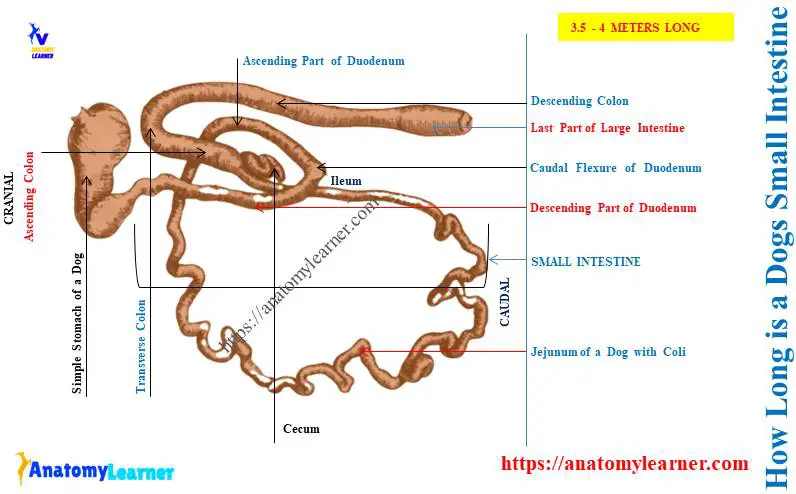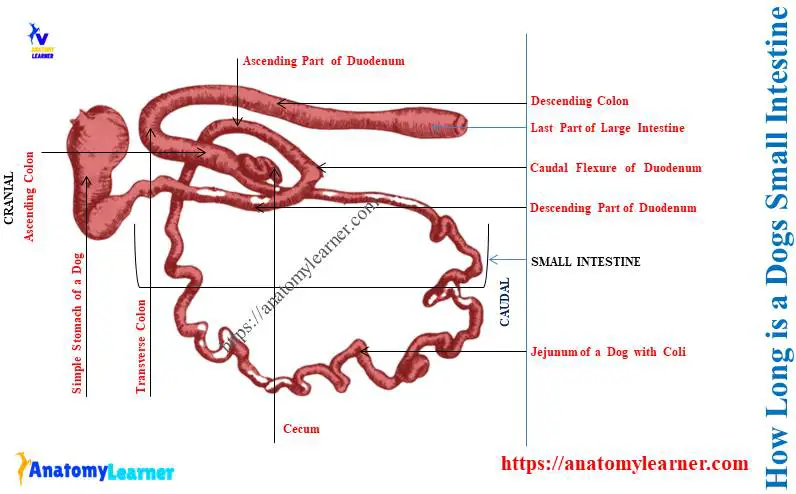The large and small intestine of a dog varies in length and diameter. If you want to know the perfect answer to the question – how long is a dogs small intestine, this article is for you.
Here, I will show you the average length of the small intestine of a medium-sized dog. You will also find the details structure of the small intestine of a dog with the labeled diagram.
Quick answer: a medium-sized dog shows a 3.5 – 4 meters long small intestine. Typically, the length of the dog’s small intestine is an average of 3.5 times higher than its body length.
To understand the total length of the dog’s small intestine, you might have the basic concept of its different parts. Here, I will provide the length of the three major parts of the dog’s small intestine individually with their anatomy.
How long is a dogs small intestine?
The dog’s small intestine is the principal site for digestion and absorption. It extends from the pylorus of the simple stomach to the large intestine.
Typically, you will find 3 distinct and identifiable segments in the structure of the dog’s small intestine –
- Duodenum – receive ingesta from the stomach,
- Jejunum – the longest part of the canine small intestine, and
- Ileum – the short and terminal part of the small intestine,
The length of these 3 segments of the canine small intestine varies with the breed, age, and size.

According to the dog anatomist, the length of the small and large intestines depends on the size of the dog and estimate by the following –
- The average length of the small intestine = 3.5 times higher than the length of the dog’s body,
But you may also estimate the length of the dog’s small intestine manually. This might be the total sum of the length of the three parts (duodenum, jejunum, and ileum).
A normal measuring tap may be used to measure the actual length of the dog small intestine’s duodenum, jejunum, and ileum. From Table 1, let’s see – how long is a dogs small intestine –
| Part of dog’s small intestine | Length of canine small intestine |
| Duodenum | 25 centimeters (0.25 meter) |
| Jejunum | 321 centimeters (3.21 meters) |
| Ileum | 10 centimeters (0.1 meter) |
These numbers show the average measurement of the various parts of the dog intestine. I have summarized the measurement of dog small intestines that veterinary anatomists provide.
Thus, the average length of the small intestine of a medium-sized dog is 3.5 meters or 350 centimeters.
Dog digestive system step by step
You know the dog’s small intestine is part of the digestive system. Thus, you might have a basic idea of the different organs of the dog’s digestive system.
Let’s see the organs from the digestive system of a dog step by step –
- Oral cavity – consists of the vestibule and oral cavity proper,
- Pharynx – has 7 openings and is common both for a dog’s digestive and respiratory system,
- Alimentary canal – includes the esophagus, simple stomach, and intestine (small and large), and
- Accessory organs – include the tongue, teeth, salivary glands, liver, gallbladder, and pancreas,
The mouth or oral cavity of a dog is a complex structure and consists of the vestibule and oral cavity proper. You may get the details anatomy of the dog mouth cavity from the below-mentioned article –
The number of teeth of a dog varies from the horse and ruminant. If you want to know the details anatomy of dog teeth, let’s read the following article –
The dog tongue is considered an accessory digestive organ, somewhat different from the ruminant tongue. The thin margins, thin apex, and longitudinal grooves make the canine tongue unique from other animals like horses and cows.
You will find 3 distinct parts in the structure of the dog tongue that I have already described in the below-mentioned article –
Alimentary canal of dog digestive system
Esophagus is the musculomembranous and first part of the dog’s alimentary canal. It starts from the pharynx of the dog and extends up to the simple stomach. You will find three parts – cervical, thoracic, and abdominal in the course of the dog esophagus.
But, the ruminant esophagus only shows two parts – cervical and thoracic; the abdominal part is absent.
The dog’s stomach is the second part of the alimentary canal. It is the largest dilation of the alimentary canal and extends between the esophagus and the small intestine.
You will find two major curvatures in the dog’s simple stomach structure – greater and lesser. Here, the greater curvature is the convex border of the dog’s stomach, whereas the lesser curvature is the concave border.
You will find similarities in the structure of the simple stomach of a dog with the abomasum part of a ruminant stomach. Let’s learn the ruminant stomach anatomy from the below-mentioned article –
This might help you to understand the basic difference between the cow and dog stomach.

Dog intestine anatomy
The diagram of the dog intestine shows two major parts based on the diameter. Here, the part of the dog intestine that shows the smaller diameter is the small intestine. In contrast, the part of the intestine with a larger diameter is the larger intestine.
The dog intestine shows a smaller diameter on its first parts. This part again subdivides into three distinct parts – duodenum, jejunum, and ileum. You will learn the details of these parts and their length in the article’s next section.
Let’s know the anatomy of the large intestine from dogs.
The large intestine of a dog is comparatively short in length. Again, the dog’s large intestine structure is more or less simple than the large intestine of cows and other animals.
You will also find 3 distinct segments in the dog’s large intestine structure – cecum, colon, and last part (shown in the diagram). Cecum is the first part of the canine large intestine and sac-like structure.
It shows an average 5 centimeters length and 2-centimeter diameter. You will find the blunt apex and larger middle body in the structure of the dog’s cecum.
There is a single or double ileocecal fold found in the junction between the ileum and cecum of the dogs. Again, you will find the cecal sphincter in between the junction of the cecum and colon of the dog’s large intestine (also known as the cecocloic orifice).
The colon is the second part of the canine large intestine and divides into three distinct parts. You will find the ascending, transverse, and descending parts in the structure of the canine colon anatomy.
The diameter of the dog’s colon is about 2 centimeters, where the diameter becomes higher (approximately 3 centimeters) in the last part of the intestine.
Length and diameter of the dog’s large intestine
The overall length of the canine large intestine is about 0.5 meters (for a medium-sized dog). Sometimes the length may increase up to 1 meter in various dog breeds.
Let’s see the length and diameter of the dog’s large intestine from Table 2 –
| Dog large intestine | Length (cm) | Diameter (cm) |
| Cecum | 8 – 10 | 0.5 – 2 |
| Colon | 25 – 35 | 1 – 2 |
| Last part | 5 – 8 | 2 – 3 |
Here, cm = centimeters, and all numbers are present as the average measurements.
How long are the intestines in a dog?
Answer: the intestines may be 4 – 5 meters long in a dog (altogether small and large intestines). This length of the intestines is appropriate for a medium-sized dog.
Table 3 shows the average length and diameter of the intestines of the dog –
| Prats of dog intestine | Length (meters) | Diameter (centimeters) |
| Small intestine | 3.5 – 4 | 0.5 – 1 |
| Large intestine | 0.5 – 1 | 1 – 3 |
So, the dog’s large intestine length is less than the small intestines. But, the diameter of the dog’s larger intestine is larger than the different parts of the small intestine.
Do dogs have a small intestine?
Yes, dogs have a small intestine that is a length of 3.5 to 4 meters and shows an average 0.5 – 1 centimeter diameter. It is the largest part of the canine intestine and distinctly possesses 3 different segments.
Here, the diagram shows three distinct and identifiable segments of the canine small intestine (duodenum, jejunum, and ileum).
The average length of the dog’s duodenum is about 0.25 meters (for medium-sized dogs). Dog’s duodenum starts from the right hypochondriac region and forms a U-shaped structure.
The anatomy of the dog duodenum shows the following –
- Two flexures – cranial and caudal duodenal flexure, and
- Four portions – cranial, descending, transverse, and ascending parts of the dog duodenum,
You will find the descending part of the canine duodenum as the largest part. It shows the approximately 15-centimeter length of the total duodenum.
It forms a strong sphincter between the last part of the simple stomach and the first part of the duodenum. And you know this is the pyloric sphincter of the canine duodenum.
Again, you may learn the details of anatomical features of the canine intestine from the below-mentioned article –
- Dog intestine anatomy – parts, length, and important features with labeled diagram,
What is the longest part of the small intestine in dogs?
Jejunum is the longest part of the small intestine in dogs. A medium-sized dog shows an average 321 centimeter (3.21 meters) long jejunum.
The jejunum of a dog starts from the duodenojejunal flexure at the left. And finally, the jejunum of a dog ends at the ileal orifice.
The jejunoileum is the most mobile and free part of the dog’s alimentary canal. You will see 7 to 8 colis in the structure of the dog jejunum. But, the colis are more in the structure of the ruminant jejunum.
The summary of the dog jejunum anatomy is provided in Table 4 –
| Anatomical Features | Dog Jejunum |
| Length | 321 centimeters (3.21 meters) |
| Diameter | 0.5 – 0.75 centimeters |
| Speciality | The longest part of the small intestine |
| Colis | 7 – 8 |
| Extension | Between the stomach and pelvic inlet |
How big is a large dog’s small intestine?
A large dog may possess a 4.5 – 5 meter-long small intestine. The larger dog may show a larger duodenum, larger colis on the jejunum, and longer ileum. But the numbers of the colis in the jejunum of a large dog remain similar to that of small dogs.
Let’s see the average length and diameter of the various parts of the small intestine of a large dog from Table 5 –
| Dog small intestine | Duodenum (cm) | Jejunum (cm) | Ileum (cm) |
| Length | 30 – 35 | 30 – 35 | 15 – 20 |
| Diameter | 2 | 1 | 1.5 |
Here, cm = centimeters, and all numbers are presented as the average measurement.
Conclusion
So the answer to the question – how long is a dogs small intestine was revealed. The average length of the dog’s small intestine is 3.5 – 4 meters with a 0.5 – 1 centimeter diameter.
Again, the dog’s larger intestine is 0.5 – 1 meter long, much smaller than the small intestine. Further studies may be performed to measure the length of the small intestine from different breeds of dogs with their anatomical features.

